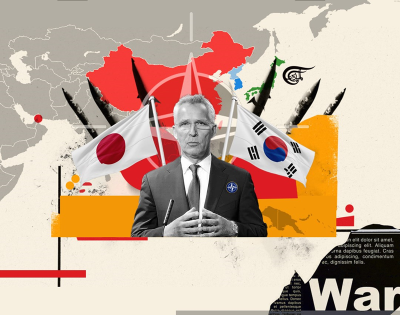Is the Trip of the Secretary General of NATO Aimed to Instigate the Creation of the Asian Version of NATO?

All Global Research articles can be read in 51 languages by activating the Translate Website button below the author’s name (desktop version)
To receive Global Research’s Daily Newsletter (selected articles), click here.
Follow us on Instagram and Twitter and subscribe to our Telegram Channel. Feel free to repost and share widely Global Research articles.
***
South Korea and Japan trying to attend to their own business by inviting unbidden guests to the region should be well aware that they are getting closer to the extreme security crisis, far from defusing security uneasiness.
It was reported that the secretary general of NATO embarked upon his trip to South Korea and Japan.
The high-ranking chief of the military organization which turned Ukraine into a theatre of proxy war is flying into the Asia-Pacific region of the eastern hemisphere across the sea and land, which is not even part of its operational sphere. This fact itself gives rise to concern.
It is well known that NATO has long made persistent attempts to expand its sphere of influence, limited to European defense, to the Asia-Pacific region, which rose to be the strategic center of the world.
NATO stages bilateral and multilateral joint military exercises under various titles by introducing armed forces of its member states, including aircraft carriers and fighters, under the pretext of opposing the so-called “change of status quo by force”. It is also mulling extending its influence to the Asia-Pacific region by expanding and strengthening cooperation with such exclusive security allies as AUKUS, Quad and Five Eyes.
In particular, NATO has put unprecedented spurs to the strengthening of bilateral relations with South Korea and Japan in recent years, regarding them as a key link in realizing its ambition for hegemony.
This is proved by the fact that the chairman of the military committee of NATO visited South Korea and Japan, respectively in April and June last year, to discuss closer partnership and military cooperation and, at the end of June, South Korea and Japan participated in the NATO summit in Madrid of Spain for the first time ever.
Meanwhile, in May last year, the Cooperative Cyber Defense Centre of Excellence under NATO registered South Korea as its full memberو and in October a delegation of the NATO Parliamentary Assembly was dispatched to South Korea to discuss the strengthening of bilateral cooperation.
South Korea signed a huge sales contract for arms including heavy tanks, self-propelled guns, and fighters valued at tens of billions of US dollars with Poland, a member state of NATO, and Japan agreed to jointly develop the next generation fighters with Britain and Italy. This clearly proves to what extent NATO’s sinister intention to use South Korea and Japan for expanding its influence has reached.
NATO, which specified Russia as the “greatest and direct threat” and China as a “systematic challenge” in its new “strategic concept” last year, is now openly stretching its long arm to South Korea and Japan. Its aim is quite clear.
It is the general orientation sought by the US-led NATO to cook up an Asian version of NATO to serve the maintenance of its hegemonic position and order in collusion with its vassal forces.
Over the recent worrying moves of NATO, it is quite natural that countries in the region have warned that NATO seeks to apply the method of collective confrontation in Asia-Pacific, which had already been used in Europe, and South Korea and Japan should not introduce NATO forces into the Asia-Pacific region.
It is as clear as noonday that the secretary general of NATO flying to south Korea and Japan, at a time when the Ukrainian crisis has entered a new critical stage with the US and Western decision on supplying tanks, will shore up the “theory of threat from China” to emphasize again the need to build Asian version of NATO and put pressure on them for their passive military support to Ukraine.
Thus, it’s only a matter of time before the military hardware of South Korea and Japan flowing into NATO is seen in the Ukrainian battlefield.
South Korea and Japan trying to attend to their own business by inviting unbidden guests to the region should be well aware that they are getting closer to the extreme security crisis, far from defusing security uneasiness.
It will be nothing good if NATO, a synonym for war and confrontation, puts its military boots on the region.
The trip of the NATO secretary general to South Korea and Japan is a prelude to confrontation and war as it brings the dark clouds of a “new Cold War” to the Asia-Pacific region.
Regional countries and the international community should remain highly vigilant against the frequent footsteps of NATO toward Asia-Pacific.
*
Note to readers: Please click the share buttons above. Follow us on Instagram and Twitter and subscribe to our Telegram Channel. Feel free to repost and share widely Global Research articles.
Featured image is from Al Mayadeen

